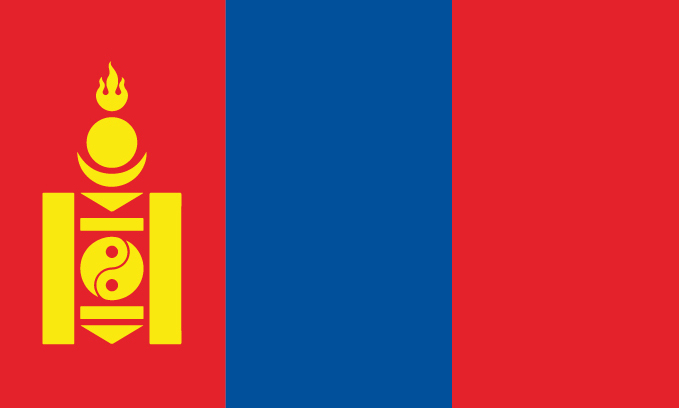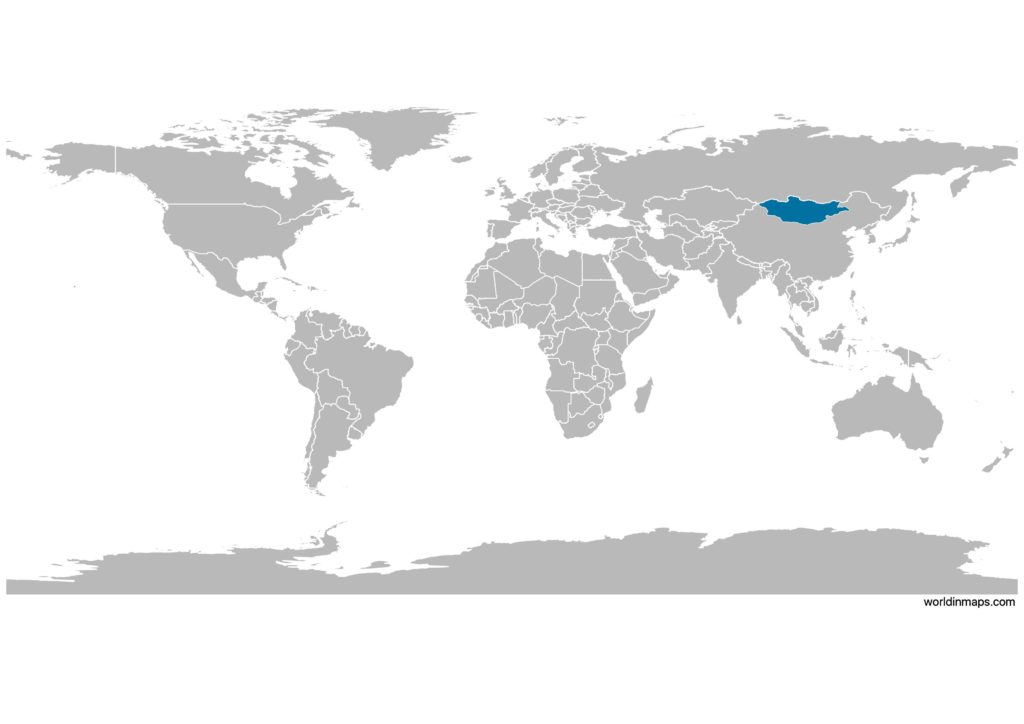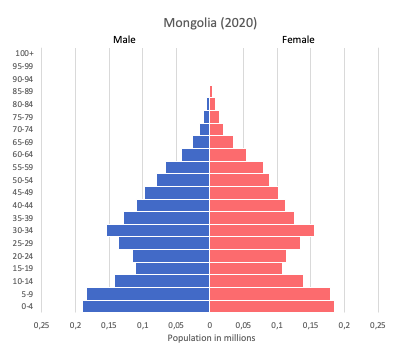Mongolia

| Government | |
| Name | Mongolia |
| Government type | semi-presidential republic |
| Capital | Ulaanbaatar (1,340,000 (2008)) |
| Currency | Tögrög (MNT) |
| Organization | |
| Observer State | Commonwealth of Independent States (CIS) |
| People | |
| Population (2020) | 3,278,292 (134th) |
| Density of population | 2.07 P/km2 (194th) |
| Nationality | Mongolian |
| Official languages | |
| Mongolian | |
| Ethnic groups (2015) | |
| Khalkh | 84.5% |
| Kazak | 3.9% |
| Dorvod | 2.4% |
| Bayad | 1.7% |
| Buryat-Bouriates | 1.3% |
| Zakhchin | 1% |
| other | 5.2% |
| Religions (2010) | |
| Buddhist | 53% |
| Muslim | 3% |
| Shamanist | 2.9% |
| Christian | 2.2% |
| other | 0.4% |
| none | 38.6% |
| Life expectancy (2020) | |
| Male | 66.6 years |
| Female | 75.2 years |
| Total population | 70.8 years (164th) |
| Homicides | |
| Total (2018) | 6.2 per 100,000 people (54th) |
| Geography | |
| Land area | 1,553,556 km2 |
| water area | 10,560 km2 |
| total area | 1,564,116 km2 (20th) |
| Mean elevation | 1,528 m |
| Lowest point | |
| Hoh Nuur | 560 m |
| Highest point | |
| Nayramadlin Orgil (Khuiten Peak) | 4,374 m |
| Land use (2011) | |
| Agricultural land | 73% |
| Arable land | 0.4% |
| Permanent crops | 0% |
| Permanent pasture | 72.6% |
| Forest | 7% |
| Other | 20% |
| Urbanization | |
| Urban population (2020) | 68.7% |
| Rate of urbanization | 1.63% annual rate of change (2015 – 2020) |
| Economy | |
| Labor force (2017) | 1.241 million (137th) |
| Labor force by occupation (2016) | |
| Agriculture | 31.1% |
| Industry | 18.5% |
| Services | 50.5% |
| Unemployment rate (2017) | 8% (116th) |
| GDP (PPP) (estimate 2019) | |
| Total | $47 billion (115th) |
| Per capita | $14,270 (93rd) |
| GDP (nominal) (estimate 2019) | |
| Total | $13.7 billion (133rd) |
| Per capita | $4,151 (116th) |
| GDP by sector (estimate 2017) | |
| Agriculture | 12.1% |
| Industry | 38.2% |
| Services | 49.7% |
| Exports (2018) | $7.012 billion (100th) |
| Exports partners (2017) | |
| China | 93.3% |
| UK | 2.5% |
| Imports (2018) | $5.875 billion (121st) |
| Imports partners (2017) | |
| China | 32.6% |
| Russia | 28.1% |
| Japan | 8.4% |
| US | 4.8% |
| South Korea | 4.6% |
Mongolia on the world map

Mongolia top 10 largest cities (2008)
- Ulaanbaatar (1,340,000)
- Erdenet (86,866)
- Darkhan (74,300)
- Choibalsan (38,150)
- Mörön (36,082)
- Khovd (28,601)
- Ölgii (27,855)
- Bayankhongor (26,252)
- Arvaikheer (25,622)
- Ulaangom (21,406)
Demography
Population pyramid

Age structure data
Estimate for 2020:
- 0-14 years: 26.96% (male 435,596/female 418,524)
- 15-24 years: 14.93% (male 239,495/female 233,459)
- 25-54 years: 45.29% (male 694,481/female 740,334)
- 55-64 years: 8.04% (male 115,560/female 139,129)
- 65 years and over: 4.78% (male 60,966/female 90,482)
Remark: the age structure of a population affects a nation’s key socioeconomic issues. Countries with young populations (high percentage under age 15) need to invest more in schools, while countries with older populations (high percentage ages 65 and over) need to invest more in the health sector. The age structure can also be used to help predict potential political issues. For example, the rapid growth of a young adult population unable to find employment can lead to unrest.
Population from 1950 to 2020
Source: United Nations, Department of Economic and Social Affairs, Population Division (2019). World Population Prospects 2019, Online Edition. Rev. 1.
Evolution of the life expectancy from 1960 to 2018
Source: World Development Indicators, The World Bank
Economy
Agriculture:
wheat, barley, vegetables, forage crops; sheep, goats, cattle, camels, horses
Industries:
construction and construction materials, mining (coal, copper, molybdenum, fluorspar, tin, tungsten, gold), oil, food and beverages, processing of animal products, cashmere and natural fiber manufacturing
Exports – commodities:
copper, apparel, livestock, animal products, cashmere, wool, hides, fluorspar, other nonferrous metals, coal, crude oil
Imports – commodities:
machinery and equipment, fuel, cars, food products, industrial consumer goods, chemicals, building materials, cigarettes and tobacco, appliances, soap and detergent
Time zone and current time in Mongolia
Go to our interactive map to get the current time in Mongolia
Historical region
- Mongolia was known by European from the Middle age to the 20th century as making part of Tartary.